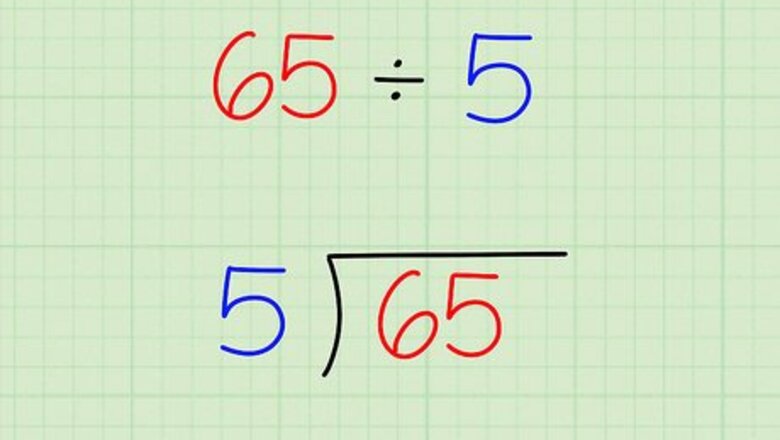
views
Long Division
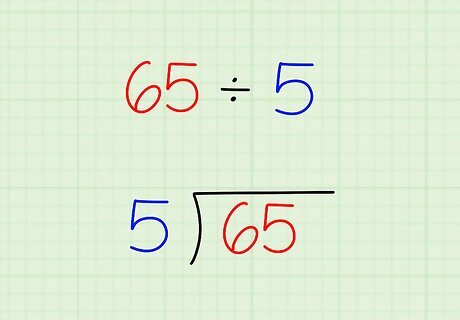
Write out the problem using a long division bar. The division bar ( 厂 ) looks like an ending parentheses attached to a horizontal line that goes over the string of numbers beneath the bar. Place the divisor, the number you'll be dividing into, outside the long division bar, and the dividend, the number that you'll be dividing, inside the long division bar. Sample problem #1 (beginner): 65 ÷ 5. Place the 5 outside the division bar, and the 65 inside it. It should look like 5厂65, but with the 65 underneath the horizontal line. Sample problem #2 (intermediate): 136 ÷ 3. Place the 3 outside the division bar, and the 136 inside it. It should look like 3厂136, but with the 136 underneath the horizontal line.
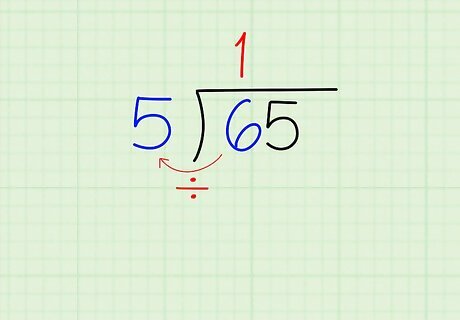
Divide the first digit of the dividend by the divisor. In other words, figure out how many times the divisor (the number outside the division bar) goes into the first digit of the dividend. Place the whole number result above the division line, right above the first digit of the divisor. In sample problem #1 (5厂65), 5 is the divisor and 6 is the first digit of the dividend (65). 5 goes into 6 one time, so place a 1 on the top of the divisor bar, aligned above the 6. In sample problem #2 (3厂136), 3 (the divisor) does not go into 1 (the first digit of the dividend) and result in a whole number. In this case, write a 0 above the division bar, aligned above the 1.
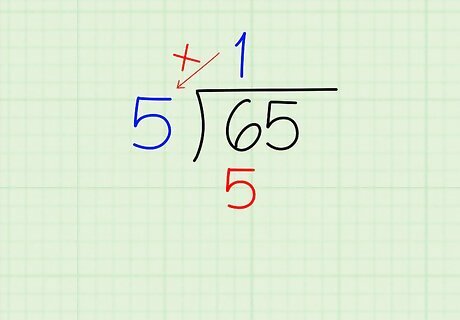
Multiply the digit above the division bar by the divisor. Take the number you just wrote above the division bar and multiply it by the divisor (the number to the left of the division bar). Write the result in a new row beneath the dividend, aligned with the first digit of the dividend. In sample problem #1 (5厂65), multiply the number above the bar (1) by the divisor (5), which results in 1 x 5 = 5, and place the answer (5) just below the 6 in 65. In sample problem #2 (3厂136), there is a zero above the division bar, so when you multiply this by 3 (the divisor), your result is zero. Write a zero on a new line just below the 1 in 136.
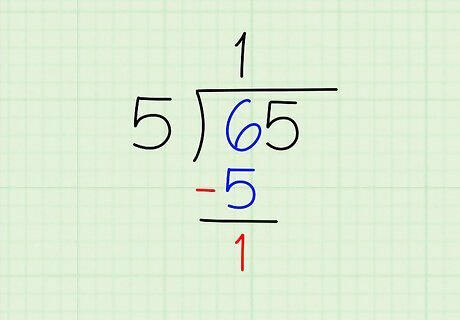
Subtract the multiplication result from the first digit of the dividend. In other words, subtract the number you just wrote in the new row below the dividend from the digit in the dividend directly above it. Write the result in a new row, in alignment with the digits from the subtraction problem. In sample problem #1 (5厂65), subtract the 5 (the multiplication result in the new row) from the 6 right above it (the first digit of the dividend): 6 - 5 = 1. Place the result (1) in another new row right below the 5. In sample problem #2 (3厂136), subtract 0 (the multiplication result in the new row) from the 1 right above it (the first digit in the dividend). Place the result (1) in another new row right below the 0.
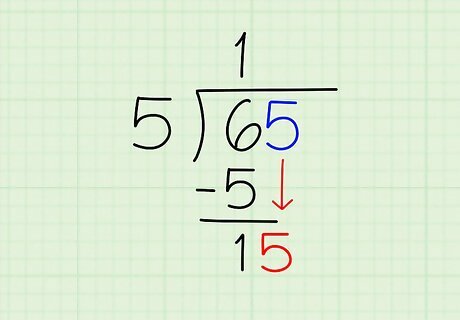
Carry down the second digit of the dividend. Drop down the second digit of the dividend to the new bottom row, just to the right of the subtraction result you just got. In sample problem #1 (5厂65), drop the 5 from 65 down so that it’s beside the 1 that you got from subtracting 5 from 6. This gives you 15 in this row. In sample problem #2 (3厂136), carry down the 3 from 136 and place it beside the 1, giving you 13.
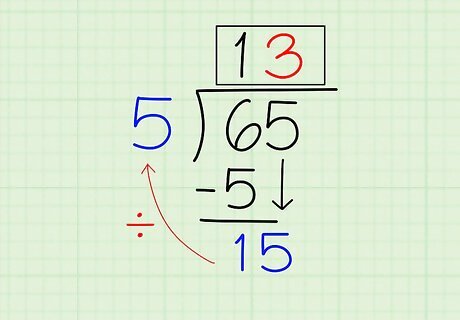
Repeat the long division process (sample problem #1). This time, use the dividend (the number to the left of the division bar) and the new number on the bottom row (the result of your first round of calculations and the digit you carried down). As before, divide, then multiply, and finally subtract to get your result. To continue 5厂65, divide 5 (the dividend) into the new number (15), and write the result (3, since 15 ÷ 5 = 3) to the right of the 1 above the division bar. Then, multiply this 3 above the bar by 5 (the dividend) and write the result (15, since 3 x 5 = 15) below the 15 under the division bar. Finally, subtract 15 from 15 and write 0 in a new bottom row. Sample problem #1 is now complete, since there are no more digits in the divisor to carry down. Your answer (13) is above the division bar.
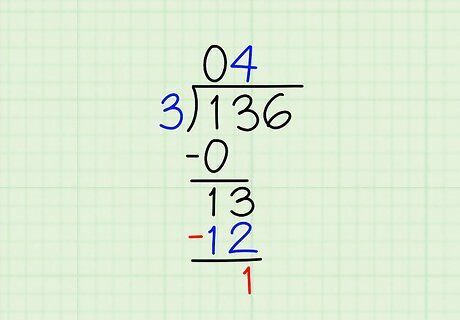
Repeat the long division process (sample problem #2). Like before, you start by dividing, then multiply, and finish up by subtracting. For 3厂136: Determine how many times 3 goes into 13, and write the answer (4) to the right of the 0 above the division bar. Then, multiply 4 by 3 and write the answer (12) below the 13. Finally, subtract 12 from 13 and write the answer (1) below the 12.
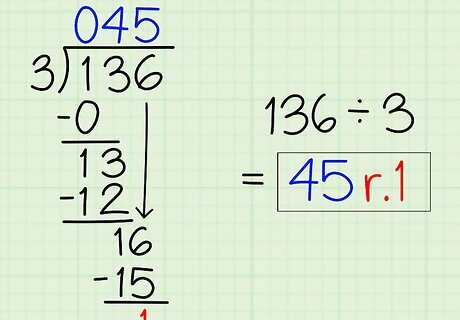
Do another round of long division and get the remainder (sample problem #2). When you’ve finished this problem, take note that there is a remainder (that is, a number left over at the end of your calculating). You'll place this remainder beside your whole number answer. For 3厂136: Continue the process for another round. Drop down the 6 from 136, making 16 in the bottom row. Divide 3 into 16, and write the result (5) above the division line. Multiply 5 by 3, and write the result (15) in a new bottom row. Subtract 15 from 16, and write the result (1) in a new bottom row. Because there are no more digits to carry down in the dividend, you’re done with the problem and the 1 on the bottom line is the remainder (the amount left over). Write it above the division bar with an “r.” in front of it, so that your final answer reads “45 r.1”.
Short Division
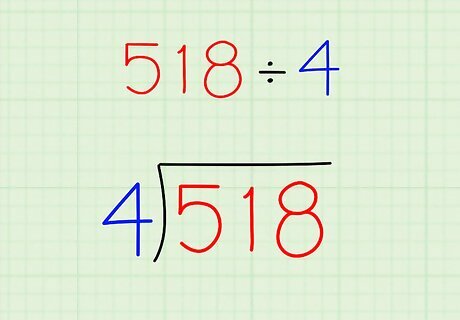
Use a division bar to write out the problem. Place the divisor, the number you'll be dividing into, outside of (and to the left of) the division bar. Put the dividend, the number that you'll be dividing, inside (to the right of and beneath) the division bar. In order to do short division, your divisor can't have more than one digit. Sample problem: 518 ÷ 4. In this case, the 4 will be outside the division bar, and the 518 inside it.
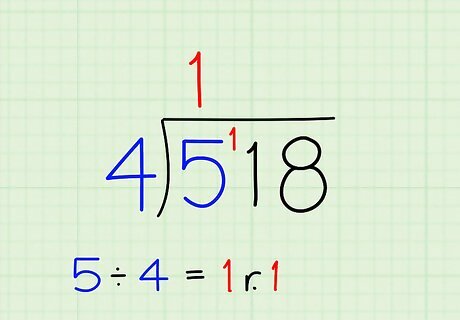
Divide your divisor into the first digit of the dividend. In other words, determine how many times the number outside the division bar will fit into the first digit of the number inside the division bar. Write the whole number result above the division bar, and write any remainder (amount left over) in superscript beside the first digit of the dividend. In the sample problem, 4 (the divisor) goes into 5 (the first digit of the dividend) 1 time, with a remainder of 1 (5 ÷ 4 = 1 r.1). Place the quotient, 1, above the long division bar. Place a small, superscript 1 beside the 5, to remind yourself that you had a remainder of 1. The 518 under the bar should now look like this: 518.
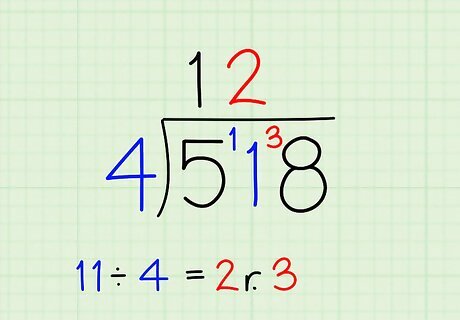
Divide the divisor into the remainder and second dividend digit. Treat the superscript number that signifies your remainder as a full-size digit, and combine it with the dividend digit immediately to its right. Determine how many times the divisor goes into this new 2-digit number, and write down whole number amount and any remainder as you did previously. In the sample problem, the number formed by the remainder and the second number of the dividend is 11. The divisor, 4, goes into 11 twice, leaving a remainder of 3 (11 ÷ 4 = 2 r.3). Write the 2 above the division line (giving you 12) and the 3 as a superscript number beside the 1 in 518. The original dividend, 518, should now look like this: 518.
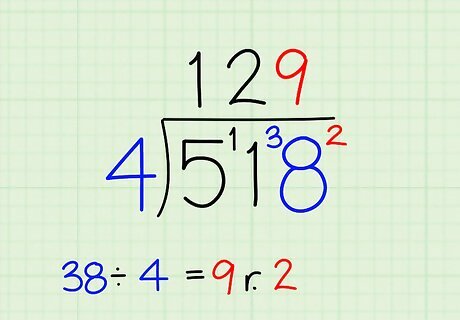
Repeat the process until you’ve gone through the entire dividend. Keep determining how many times the divisor goes into the number formed by the next digit of the dividend and the superscript remainder immediately to its left. Once you’ve worked your way through all the digits in the dividend, you’ll have your answer. In the sample problem, the next (and final) dividend number is 38—the remainder 3 from the previous step, and the number 8 as the last term of the dividend. The divisor, 4, goes into 38 nine times with a remainder of 2 (38 ÷ 4 = 9 r.2), because 4 x 9 = 36, which is 2 short of 38. Write this final remainder (2) above the division bar to complete your answer. Therefore, your final answer above the division bar is 129 r.2.
Dividing Fractions
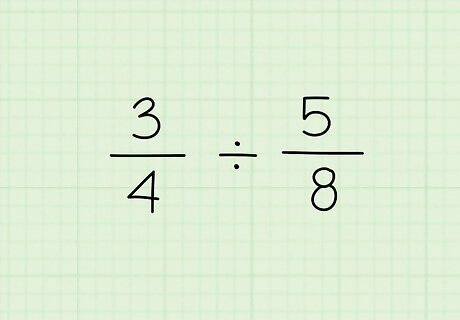
Write the equation so the 2 fractions are side-by-side. To divide fractions, simply write the first fraction followed by the division symbol (÷) and the second fraction. Your problem might be, for example, 3/4 ÷ 5/8. For convenience, use horizontal instead of diagonal lines to separate the numerator (top number) and denominator (bottom number) of each fraction.
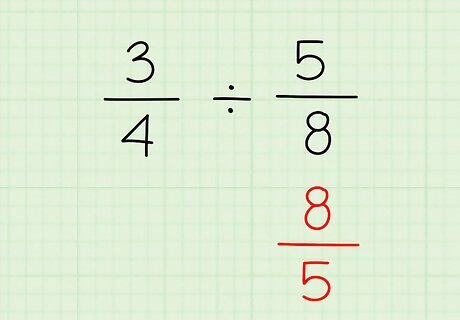
Reverse the numerator and denominator of the second fraction. The second fraction becomes its own reciprocal. In the sample problem, reverse 5/8 so the 8 is on top and the 5 is on the bottom.
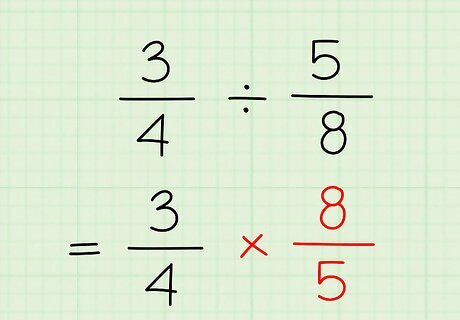
Change the division sign to a multiplication sign. To divide fractions, you multiply the first fraction by the reciprocal of the second. For example: 3/4 x 8/5.
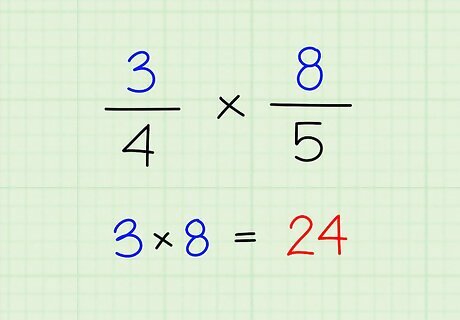
Multiply the numerators of the fractions. Follow the same procedure you would when multiplying any 2 fractions. In this case, the numerators are 3 and 8, and 3 x 8 = 24.
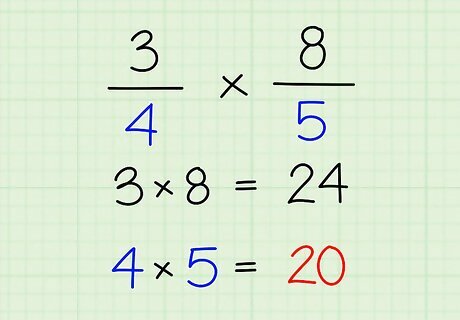
Multiply the denominators of the fractions in the same way. Once again, this is exactly what you would do to multiply any 2 fractions. The denominators are 4 and 5 in the sample problem, and 4 x 5 = 20.
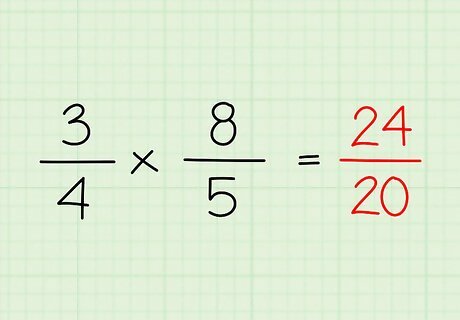
Place the product of the numerators over the product of the denominators. Now that you've multiplied the numerators and denominators of both fractions, you can form the product of the two fractions. In the sample problem, then, 3/4 x 8/5 = 24/20.
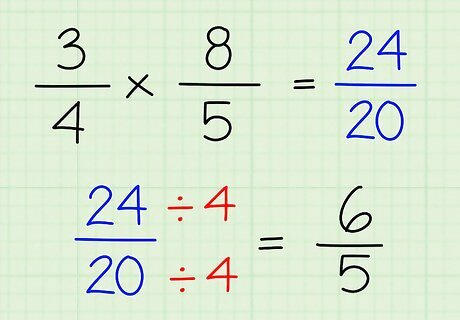
Reduce the fraction, if necessary. To reduce the fraction, find the greatest common factor, or the largest number that divides evenly into both numbers, and then divide both the numerator and denominator by that number. In the case of 24/20, 4 is the largest number that goes evenly into both 24 and 20. You can confirm this by writing out all of the factors of both numbers and picking out the largest number that is a factor of both: 24: 1, 2, 3, 4, 6, 8, 12, 24 20: 1, 2, 4, 5, 10, 20 Since 4 is the greatest common factor of 24 and 20, divide both numbers by 4 to reduce the fraction. 24/4 = 6 20/4 = 5 24/20 = 6/5. Therefore, 3/4 ÷ 5/8 = 6/5
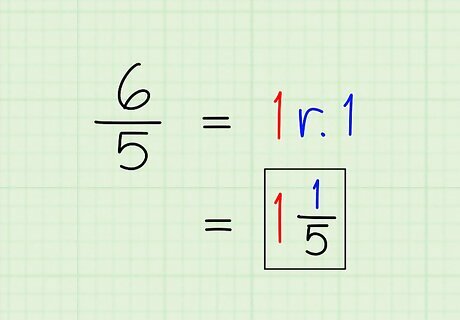
Rewrite the fraction as a mixed number, if required. To do this, divide the denominator into the numerator and write the answer as your whole number. The remainder, or the number that is left over, will be the numerator of the new fraction. The denominator of the fraction will remain the same. In the sample problem, 5 goes into 6 one time with a remainder of 1. Therefore, the new whole number is 1, the new numerator is 1, and the denominator remains 5. As a result, 6/5 = 1 1/5.
Dividing Exponents
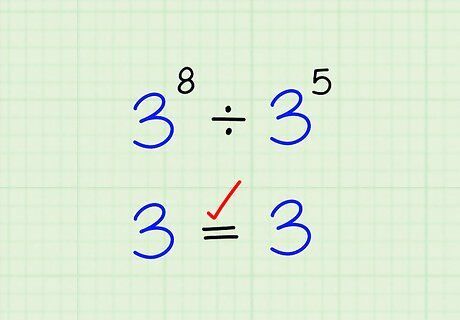
Make sure the exponents have the same base. You can only divide numbers with exponents if they have the same base. If they don't have the same base, you'll have to manipulate them until they do, if it's possible. As a beginner, start with a sample problem in which both numbers with exponents already have the same base—for instance, 3 ÷ 3.
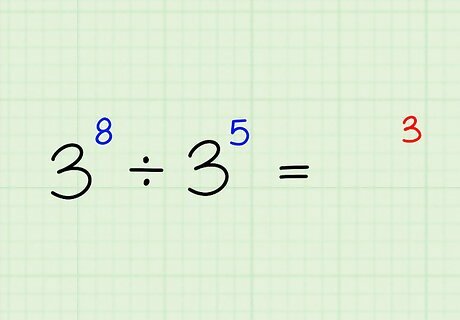
Subtract the exponents. Simply subtract the second exponent from the first. Don't worry about the base for now. In the sample problem: 8 - 5 = 3.
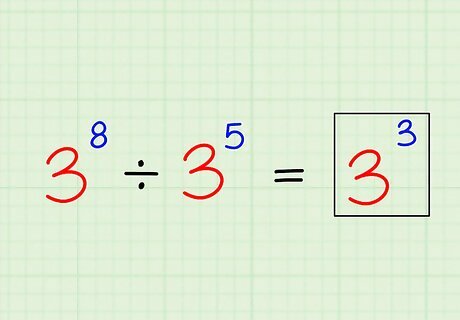
Place the new exponent above the original base. Simply write the new exponent above the original base. That’s it! Therefore: 3 ÷ 3 = 3.
Dividing Decimals
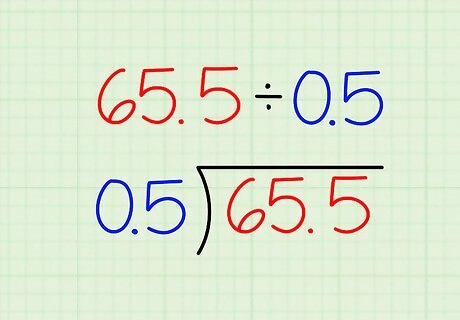
Write the problem out with a division bar. Place the divisor, the number you'll be dividing into, outside (and to the left of) the long division bar, and the dividend, the number that you'll be dividing, inside the long division bar. To divide decimals, you’ll first convert the decimals into whole numbers. For the example 65.5 ÷ 0.5, 0.5 goes outside the division bar, and 65.5 goes inside it.
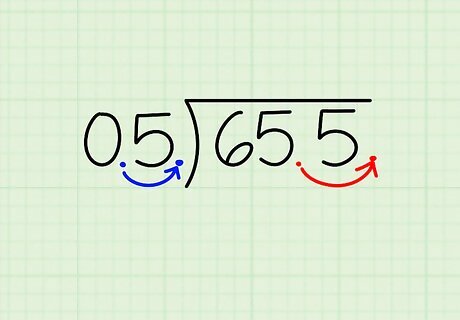
Move the decimal points the same amount to create 2 whole numbers. Just slide the decimal points to the right until they're at the end of each number. Make sure you move them the same amount for each number, though—if you have to move the decimal point 2 spots in the divisor, do the same for the dividend. In the sample problem, you only need to move the decimal point over one spot for both the divisor and dividend. So, 0.5 becomes 5, and 65.5 becomes 655. If, however, the sample problem used 0.5 and 65.55, you’d need to move the decimal point 2 places in 65.55, making it 6555. As a result, you’d also have to move the decimal point in 0.5 2 places. To do this, you’d add a zero to the end and make it 50.
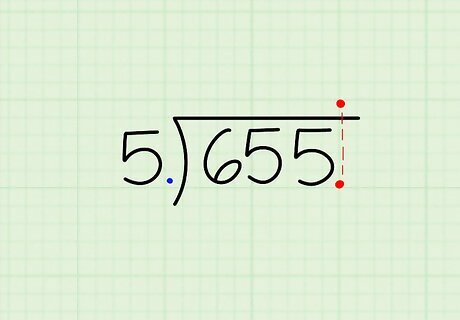
Align the decimal point above the division bar properly. Place a decimal point on the long division bar directly above the decimal in the dividend. In the sample problem, the decimal in 655 would appear after the last 5 (as 655.0). So, write the decimal point above the division line right above where that decimal point in 655 would appear.
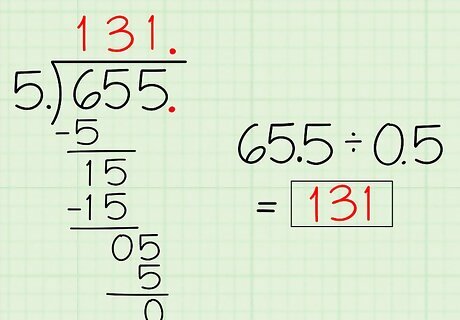
Solve the problem by doing long division. To divide 5 into 655, do the following: Divide 5 into the hundredths digit, 6. You get 1 with a remainder of 1. Place 1 in the hundredths place on top of the long division bar, and subtract 5 from 6 below the number six. Your remainder, 1, is left over. Carry the first five in 655 down to create the number 15. Divide 5 into 15 to get 3. Place the three above the long division bar, next to the 1. Carry down the last 5. Divide 5 into 5 to get 1, and place the 1 on top of the long division bar. There is no remainder, since 5 goes into 5 evenly. The answer is the number above the long division bar (131), so 655 ÷ 5 = 131. If you pull out a calculator, you’ll see that this is also the answer to the original division problem, 65.5 ÷ 0.5.















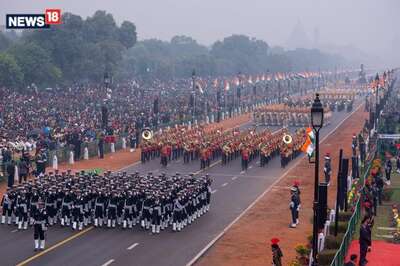

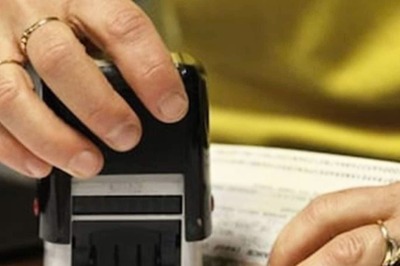
Comments
0 comment